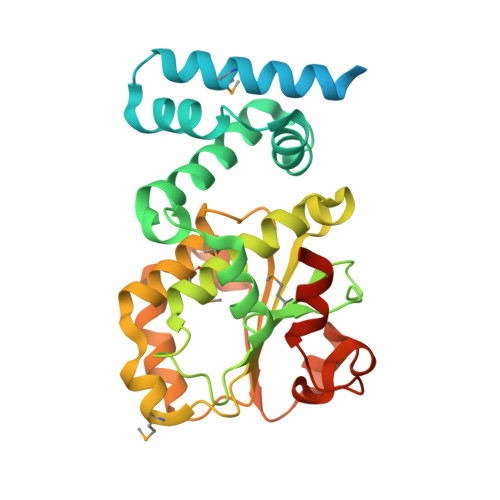Bothnia dystrophy is caused by domino-like rearrangements in cellular retinaldehyde-binding protein mutant R234W.
He, X., Lobsiger, J., Stocker, A.(2009) Proc Natl Acad Sci U S A 106: 18545-18550
- PubMed: 19846785
- DOI: https://doi.org/10.1073/pnas.0907454106
- Primary Citation of Related Structures:
3HX3, 3HY5 - PubMed Abstract:
Cellular retinaldehyde-binding protein (CRALBP) is essential for mammalian vision by routing 11-cis-retinoids for the conversion of photobleached opsin molecules into photosensitive visual pigments. The arginine-to-tryptophan missense mutation in position 234 (R234W) in the human gene RLBP1 encoding CRALBP compromises visual pigment regeneration and is associated with Bothnia dystrophy. Here we report the crystal structures of both wild-type human CRALBP and of its mutant R234W as binary complexes complemented with the endogenous ligand 11-cis-retinal, at 3.0 and 1.7 A resolution, respectively. Our structural model of wild-type CRALBP locates R234 to a positively charged cleft at a distance of 15 A from the hydrophobic core sequestering 11-cis-retinal. The R234W structural model reveals burial of W234 and loss of dianion-binding interactions within the cleft with physiological implications for membrane docking. The burial of W234 is accompanied by a cascade of side-chain flips that effect the intrusion of the side-chain of I238 into the ligand-binding cavity. As consequence of the intrusion, R234W displays 5-fold increased resistance to light-induced photoisomerization relative to wild-type CRALBP, indicating tighter binding to 11-cis-retinal. Overall, our results reveal an unanticipated domino-like structural transition causing Bothnia-type retinal dystrophy by the impaired release of 11-cis-retinal from R234W.
Organizational Affiliation:
Department of Chemistry and Biochemistry, University of Bern, 3012 Bern, Switzerland.
















